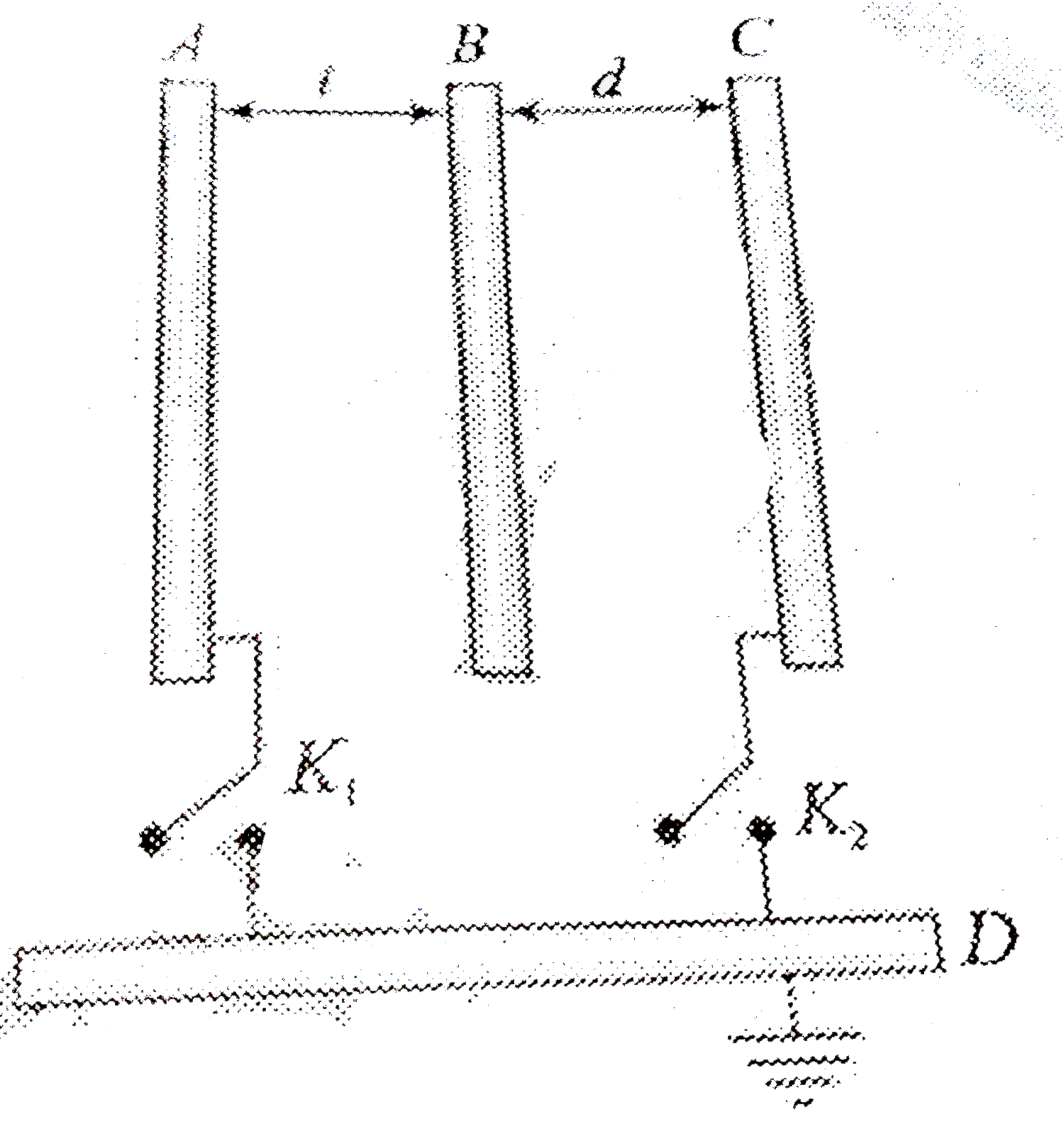The electrostatic potential on the surface of a charged concducting sphere is 100V. Two statements are made in this regard
S1: at any inside the sphere, electric intensity is zero.
S2: at any point inside the sphere, the electrostatic potential is 100V.
S1 is true but S2 is false
Both S1andS2 are false
S1 is true, S2is also true and S1 is the cause of S2
S1 is true, S2 is also true but the statements are independent.
The correct Answer is:C
To solve the problem, we need to analyze the two statements regarding the electrostatic potential and electric field inside a charged conducting sphere.
1. Understanding the Properties of Conductors:
- In electrostatics, when a conductor is charged, the electric field inside the conductor is zero. This is due to the movement of free electrons within the conductor, which redistribute themselves to cancel any internal electric fields.
2. Electric Field Inside the Sphere:
- Since the electric field intensity (E) inside the conducting sphere is zero, we can state:
E=0
- The relationship between electric field and potential is given by:
E=−dVdr
- If E=0, it implies that:
dVdr=0
- This means that the potential V is constant throughout the interior of the sphere.
3. Potential Inside the Sphere:
- The problem states that the electrostatic potential on the surface of the charged conducting sphere is 100V. Since the potential is constant inside the conductor, we conclude that:
V=100V(inside the sphere)
4. Evaluating the Statements:
- Statement S1: "At any point inside the sphere, electric intensity is zero."
- This statement is true because we established that the electric field inside a charged conductor is zero.
- Statement S2: "At any point inside the sphere, the electrostatic potential is 100V."
- This statement is also true because the potential is constant and equal to the surface potential of 100V.
5. Conclusion:
- Both statements are true. However, the reason for the second statement being true is the first statement. Thus, we conclude:
- S1 is true.
- S2 is true.
- S1 is the cause of S2.
Final Answer:
Both statements are true, and S1 is the reason for S2.
---
- In electrostatics, when a conductor is charged, the electric field inside the conductor is zero. This is due to the movement of free electrons within the conductor, which redistribute themselves to cancel any internal electric fields.
- Since the electric field intensity (E) inside the conducting sphere is zero, we can state:
E=0
- The relationship between electric field and potential is given by:
E=−dVdr
- If E=0, it implies that:
dVdr=0
- This means that the potential V is constant throughout the interior of the sphere.
- The problem states that the electrostatic potential on the surface of the charged conducting sphere is 100V. Since the potential is constant inside the conductor, we conclude that:
V=100V(inside the sphere)
- Statement S1: "At any point inside the sphere, electric intensity is zero."
- This statement is true because we established that the electric field inside a charged conductor is zero.
- Statement S2: "At any point inside the sphere, the electrostatic potential is 100V."
- This statement is also true because the potential is constant and equal to the surface potential of 100V.
- Both statements are true. However, the reason for the second statement being true is the first statement. Thus, we conclude:
- S1 is true.
- S2 is true.
- S1 is the cause of S2.
Both statements are true, and S1 is the reason for S2.
Topper's Solved these Questions
- ELECTROSTATIC POTENTIAL AND CAPACITANCE Book:NCERT FINGERTPS ENGLISHChapter:ELECTROSTATIC POTENTIAL AND CAPACITANCE Exercise:ASSERTION & REASON
Explore 15 Videos
- ELECTROSTATIC POTENTIAL AND CAPACITANCE Book:NCERT FINGERTPS ENGLISHChapter:ELECTROSTATIC POTENTIAL AND CAPACITANCE Exercise:Electric Potential
Explore 3 Videos
- ELECTROSTATIC POTENTIAL AND CAPACITANCE Book:NCERT FINGERTPS ENGLISHChapter:ELECTROSTATIC POTENTIAL AND CAPACITANCE Exercise:HOTS
Explore 5 Videos
- ELECTROMAGNETIC WAVESBook:NCERT FINGERTPS ENGLISHChapter:ELECTROMAGNETIC WAVESExercise:Assertion And Reason
Explore 15 Videos
- MAGNETISM AND MATTER Book:NCERT FINGERTPS ENGLISHChapter:MAGNETISM AND MATTER Exercise:NCERT Exemplar
Explore 5 Videos
Similar Questions
The electric potential on the surface of a sphere of radius R and charge 3×10−6 C is 500 V The intensity of electric field on the surface of the sphere ( inNC−1) is
View SolutionThe electrostatic potential V at any point (x, y, z) in space is given by V=4x2
View SolutionPotential at a point x-distance from the centre inside the conducting sphere of radius R and charged with charge Q is
View SolutionA point charge q is placed at a distance of r from cebtre of an uncharged conducting sphere of rad R(<r). The potential at any point on the sphere is
View SolutionAn insulating solid sphere of radius R has a uniformly positive charge density ρ. As a result of this uniform charge distribution there is a finite value of electric potential at the centre of the sphere, at the surface of the sphere and also at a point out side the sphere. The electric potential at infinity is zero.
Statement-1: When a charge 'q' is taken from the centre to the surface of the sphere, its potential energy changes by qρ3∈0
Statement-2 : The electric field at a distance r(r<R) from the centre of the the sphere is ρr3∈0
View SolutionThree plates A, B and C are placed close to each other with +Q charge given to the middle plate. The inner surfaces to A and C can be connected to earth through plate D and keys K1 and K2 . The plates D is a dielectric slab with dielectric constant K1 then the charge that will flow through plate D and keys K1 and K2 . The plate D is a dielectric slab with dielectric constant K, then the charge that will flow though plate D when K2 is closed and K2 is open is

View SolutionA solid insulating sphere of radius R is given a charge Q. If at a point inside the sphere the potential is 1.5 times the potential at the surface, this point will be
View SolutionTwo concentric hollow conducting spheres of radius r and R are shown. The charge on outer shell is Q. what charge should be given to inner sphere so that the potential at any point P outside the outer sphere is zero ?

View SolutionIf the potential at the centre of a uniformly charged hollow sphere of radius R is V, then electric field at a distance r from the centre of sphere will be (r>R).

View SolutionA hollow charged metal sphere has radius r. If the potential difference between its surface and a point at a distance 3r from the centre is V, then electric field intensity at a distance 3r is
View Solution